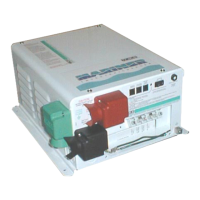,167$//$7,21
&RS\ULJKW7UDFH(QJLQHHULQJ&R,QF 7HOHSKRQH 3DUW1XPEHU
WK
6WUHHW1( )D[ 2FWREHU
$UOLQJWRQ:$86$ ZZZWUDFHHQJLQHHULQJFRP
3DJH
To avoid this problem, route your positive and negative DC cables in parallel, as close together as
possible. Secure the cables against movement with clamps or straps every 18 inches. Avoid routing
conductors near heat sources such as dry exhaust or furnace piping. Avoid chafing sources such as
steering cables, engine shafts, and throttle connections.
ABYC E-9.16
Conduit, tape, raceways or other protection shall protect conductors exposed to physical damage. Conductors passing
through bulkheads or other structural members shall be protected to minimize insulation damage such as chafing.
Conductors shall be supported throughout their length, or shall be secured at least every 18 inches by non-metallic
clamps or metal straps or clamps with smooth, rounded edges and an insulating material to prevent damage to the
cable. Wiring shall be installed in such a manner that magnetic loops in the area of the compass and magnetically
sensitive devices are avoided. Junction boxes and other enclosures in which electrical connections are made shall be
weatherproof or installed in a protected location. No more than four conductors shall be secured to any one terminal
stud. Twist-on connectors (wire nuts) shall not be used. Solder shall not be the sole means of mechanical connection
in any circuit.
DC Over Current Protection
For safety and to comply with regulations, battery over-current protection is required. Fuses and
disconnects must be sized to protect the wiring in the system. The fuse is required to blow before the
wire reaches its maximum current carrying capability. The ABYC and Federal Regulations (CFRs)
require a fuse or breaker within 7-inches of the current source (unless the conductor is attached to
the battery terminal itself, then it must be within 72 inches) and rated to match the cable’s ampacity at
75º C to protect the cables. The NEC also allows rounding up to the next fuse size from the cable
rating, i.e. 150-amp cable size rounds up to a 175-amp fuse size. See the table on Page 69 to
determine the proper fuse size for the cables you are using.
These installation parts are not supplied as part of the inverter. However, Trace Engineering offers a
DC-rated class T fuse and safety-covered fuse block that are compatible with the Mariner inverter.
The fuses are available in 110, 200, 300, and 400 amp sizes. Contact your Trace dealer to order;
see the
Options
section of this manual for more information.
Table 5, Maximum Fuse Rating in Free Air
Cable Size Rating in Free Air Maximum Fuse Size Trace Part Number
00 AWG 265 amps maximum 300 Amp TBF300
0000 AWG 360 amps maximum 400 Amp TBF400

